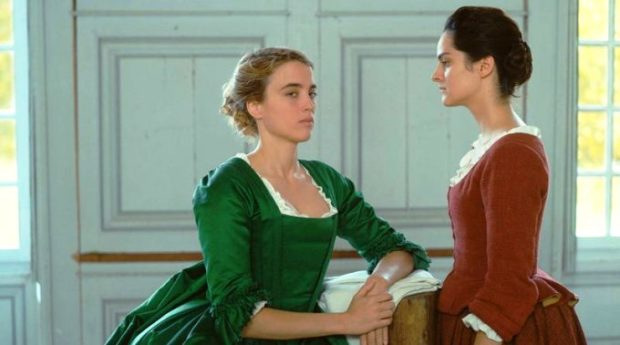 Celine Sciamma's remarkably intimate, elegant drama about the bonds between women explores the path of women artists, and how love is fostered when women see and acknowledge one another. A woman painter in an age (the 18th century) when such women were rare, is hired to paint a portrait of a countess’s daughter, who is living on a windswept island off the coast of Brittany. This is the premise of a film that seems itself like a painting in motion, Portrait of a Lady on Fire, written and directed by Céline Sciamma. In a brief intro we meet Marianne, played by Noémie Merlant, who is teaching art to a classroom of girls, being asked about the painting which gives the film its name. The rest is flashback. We then see Marianne being taken in a small rowboat to an island, when a large box of her canvases falls overboard. She jumps in and retrieves it, which shows how important art is to her. Then she’s deposited, shivering wet, on shore. At a large nearby country house, she is let in by the maid Sophie, played by Luàna Bajrami. Eventually she meets the widowed Countess, and learns that her daughter, whose name, we eventually learn, is Héloïse, has been promised in marriage to a gentleman from Milan. He was to be sent a portrait, but Héloïse wouldn’t sit for the previous painter. So the mother is practicing a deception: Marianne is supposedly just there for companionship, to take walks with Héloïse, but her real assignment is to paint the young woman surreptitiously, from memory. More disturbing is the fact that there was another daughter, an older sister, who jumped off a cliff rather than be married off. Héloïse has been summoned from a convent to take her dead sister’s place. At first, the dramatic tension lies in our wondering whether Héloïse will suspect what Marianne is up to. And just like the painter, we only gradually get to know Héloïse through her voice, face, and gestures. She is played by Adèle Haenel, and hers is a subtle, captivating performance. This woman’s gaze can seem aloof and withholding, but then passion and vulnerability emerge. The film becomes something different and more wonderful: a study of a bond developing between these two women, and how it is tested; the establishment of respect, and trust, and eventually love. There is a third woman who joins in this story: the servant, Sophie. The Countess leaves the island for a week, and the three remaining women live in a state of equality. Sophie learns that she is pregnant. Marianne and Héloïse seek to help her out of her predicament, with exercises and herbs, and eventually the services of a village midwife. Héloïse now knows about the portrait. Maybe she knew all along. Trusting Marianne, she agrees to pose. There is no escaping Héloïse’s fate: because of her family fortune, she must, according to the rules of that age, agree to the marriage. This is a brief time of paradise before the fall. Consolation lies in the belief that happiness lies not in the amount of time together, but in cherished memories. Expanding on this, the film shows the three women reading aloud the myth of Orpheus—how he tried to retrieve his lover, Eurydice, from the underworld—and they explore different ideas of what the myth really means. In a similar way, Céline Sciamma takes the old romances and infuses them with a vision of love and connection that today we know as lesbian, but at that time had no name. Sciamma uses this period, the 1700s, because it was a time when women’s autonomy, socially and artistically, was more severely restricted. Love is so natural here, yet so secret. The cinematography by Claire Mathon is painterly, vibrant and alive. Sciamma’s direction is precise and elegant. There is no musical score—the emotions occur within a silence that pervaded the daily life of the centuries before ours. Portrait of a Lady on Fire is remarkable for its alert intelligence and intimacy, and for its commitment to the vision of women artists.
Celine Sciamma's remarkably intimate, elegant drama about the bonds between women explores the path of women artists, and how love is fostered when women see and acknowledge one another. A woman painter in an age (the 18th century) when such women were rare, is hired to paint a portrait of a countess’s daughter, who is living on a windswept island off the coast of Brittany. This is the premise of a film that seems itself like a painting in motion, Portrait of a Lady on Fire, written and directed by Céline Sciamma. In a brief intro we meet Marianne, played by Noémie Merlant, who is teaching art to a classroom of girls, being asked about the painting which gives the film its name. The rest is flashback. We then see Marianne being taken in a small rowboat to an island, when a large box of her canvases falls overboard. She jumps in and retrieves it, which shows how important art is to her. Then she’s deposited, shivering wet, on shore. At a large nearby country house, she is let in by the maid Sophie, played by Luàna Bajrami. Eventually she meets the widowed Countess, and learns that her daughter, whose name, we eventually learn, is Héloïse, has been promised in marriage to a gentleman from Milan. He was to be sent a portrait, but Héloïse wouldn’t sit for the previous painter. So the mother is practicing a deception: Marianne is supposedly just there for companionship, to take walks with Héloïse, but her real assignment is to paint the young woman surreptitiously, from memory. More disturbing is the fact that there was another daughter, an older sister, who jumped off a cliff rather than be married off. Héloïse has been summoned from a convent to take her dead sister’s place. At first, the dramatic tension lies in our wondering whether Héloïse will suspect what Marianne is up to. And just like the painter, we only gradually get to know Héloïse through her voice, face, and gestures. She is played by Adèle Haenel, and hers is a subtle, captivating performance. This woman’s gaze can seem aloof and withholding, but then passion and vulnerability emerge. The film becomes something different and more wonderful: a study of a bond developing between these two women, and how it is tested; the establishment of respect, and trust, and eventually love. There is a third woman who joins in this story: the servant, Sophie. The Countess leaves the island for a week, and the three remaining women live in a state of equality. Sophie learns that she is pregnant. Marianne and Héloïse seek to help her out of her predicament, with exercises and herbs, and eventually the services of a village midwife. Héloïse now knows about the portrait. Maybe she knew all along. Trusting Marianne, she agrees to pose. There is no escaping Héloïse’s fate: because of her family fortune, she must, according to the rules of that age, agree to the marriage. This is a brief time of paradise before the fall. Consolation lies in the belief that happiness lies not in the amount of time together, but in cherished memories. Expanding on this, the film shows the three women reading aloud the myth of Orpheus—how he tried to retrieve his lover, Eurydice, from the underworld—and they explore different ideas of what the myth really means. In a similar way, Céline Sciamma takes the old romances and infuses them with a vision of love and connection that today we know as lesbian, but at that time had no name. Sciamma uses this period, the 1700s, because it was a time when women’s autonomy, socially and artistically, was more severely restricted. Love is so natural here, yet so secret. The cinematography by Claire Mathon is painterly, vibrant and alive. Sciamma’s direction is precise and elegant. There is no musical score—the emotions occur within a silence that pervaded the daily life of the centuries before ours. Portrait of a Lady on Fire is remarkable for its alert intelligence and intimacy, and for its commitment to the vision of women artists.

A portrait of a normal seeming American family, with a subversive style revealing its inherent dysfunction. The Cathedral, the remarkable sophomore feature by Ricky...

The Wrong Box showcases a kind of inspired silliness exclusive to the British. There’s a special place in my heart for silly comedies. I...

A day in the life of an abused young girl, presented by director Robert Bresson as the epitome of unjust human suffering. In the...